Transmission Replacement With 8.1L (L18) Engine
Tools Required
| • | J 21366 Converter Holding Strap |
| • | J 44257 Connector Removal Tool |
Removal Procedure
Important: If replacing a failed transmission, the "FastLearn" (adapt) procedure must be performed. This can be done in one step using a scan tool. If this procedure is not done, the transmission control module's (TCM's) adaptive valves will be at the settings that it learned for the old transmission, and will be in slow adaptive mode. Under these conditions, it would take an unacceptably long time for the adaptive values to converge to levels suitable for the new transmission.
- Disconnect the negative battery cable. Refer to Battery Negative Cable Disconnection and Connection .
- Remove the transmission fluid level indicator.
- Raise and suitably support the vehicle. Refer to Lifting and Jacking the Vehicle .
- Remove the engine protection shield bolts and shield.
- Remove the starter motor bolts and position the starter motor aside.
- Drain the transmission fluid, if necessary.
- If the vehicle is a 2-wheel drive (2WD), remove the propeller shaft. Refer to One-Piece Propeller Shaft Replacement or Two-Piece Propeller Shaft Replacement .
- Support the transmission with a transmission jack.
- If the vehicle is a 2WD, remove the transmission mount nuts.
- If the vehicle is a 2WD, remove the transmission support bracket bolts.
- If the vehicle is a 2WD, remove the transmission support bolts and nuts.
- If the vehicle is a 2WD, remove the transmission support.
- If the vehicle is equipped with 4-wheel drive (4WD), remove the transfer case.
- Remove the transmission mount bolts (1).
- Remove the transmission mount.
- Disconnect the shift cable from the selector lever ball stud (5) and remove the cable from the bracket (3).
- Remove the shift cable bracket bolts and bracket (2) from the transmission.
- Disconnect the turbine speed sensor (1) and input speed sensor (2) electrical connectors.
- Disconnect the output speed sensor (3) electrical connector. If the vehicle is equipped with 4WD, the output speed sensor is located on the transfer case and will already be disconnected.
- Disconnect the transmission main electrical connector. J 44257 may be used, but is not required.
- Disconnect the park neutral position (PNP) switch electrical connector.
- Remove the fuel line retainer (1) bolts on the left side of the transmission.
- Remove the transmission heat shield bolt and nut (4, 5) and shield (3).
- Remove the exhaust pipe hanger bolts and reposition the hanger.
- Remove the transmission heat shield bolts (2) and shield (1).
- Remove the converter housing inspection cover bolts and cover.
- Rotate the engine clockwise, using the crankshaft bolt in order to access the torque converter bolts through the starter opening. Have an assistant rotate the engine while aligning the bolts.
- Remove the torque converter bolts (3).
- Remove the transmission fill tube nuts from the converter housing studs.
- Remove the fuel line bracket nut from the converter housing stud.
- Remove the wire harness/vent tube bracket nut from the converter housing stud and reposition the bracket.
- Secure a safety chain around the transmission. Use care not to overlap any wiring, fuel lines, or other related components.
- Disconnect the transmission oil cooler lines (1, 2) from the transmission.
- Plug the transmission oil cooler line fittings in the transmission case.
- If the vehicle is equipped with a power take off (PTO) unit , disconnect and/or remove any necessary components to facilitate transmission removal.
- Remove the remaining converter housing bolts and studs.
- Separate the transmission from the engine.
- Install J 21366 to the converter housing in order to keep the torque converter from sliding off of the turbine shaft.
- Carefully lower the transmission from the vehicle while simultaneously removing the fill tube.
- Remove the J 21366 .

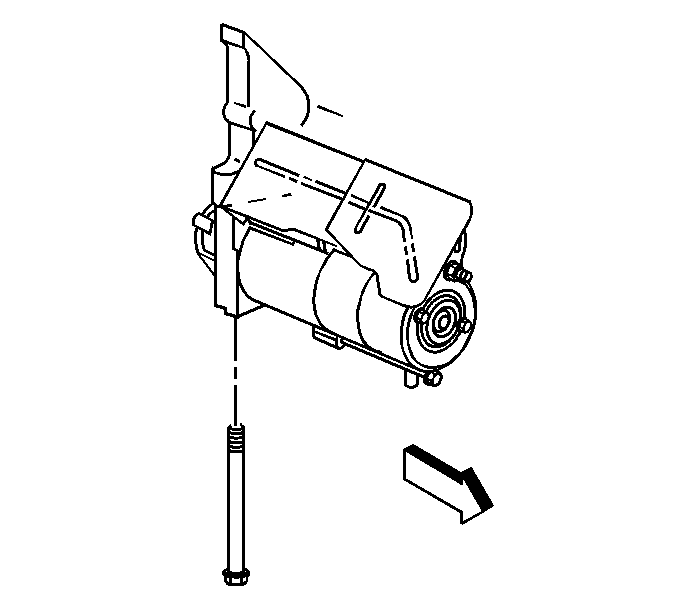
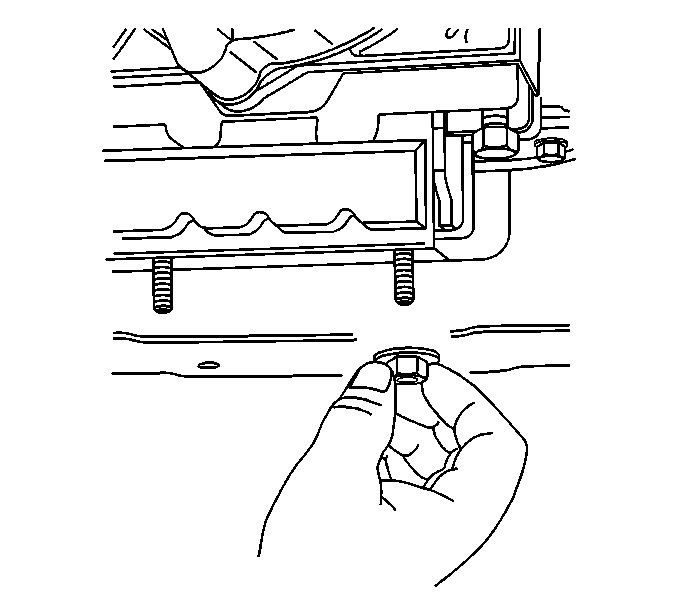
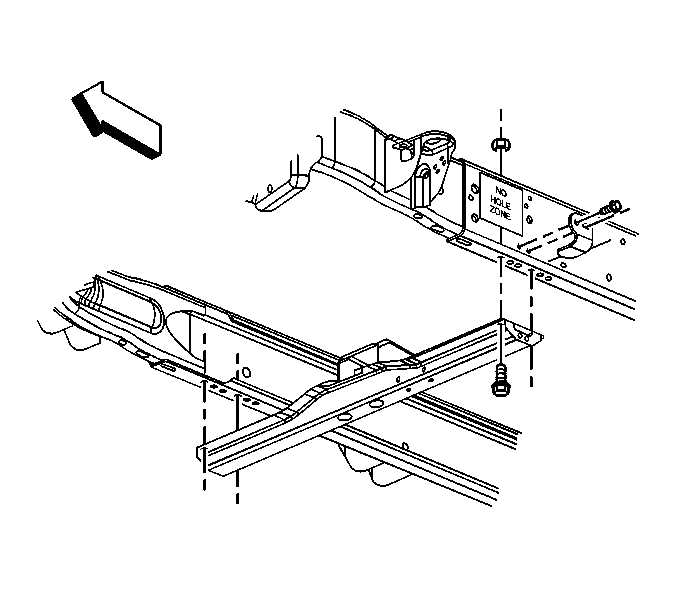
| • | If equipped with a NVG 261-NP2, refer to Transfer Case Assembly Replacement . |
| • | If equipped with a NVG 263-NP1, refer to Transfer Case Assembly Replacement . |
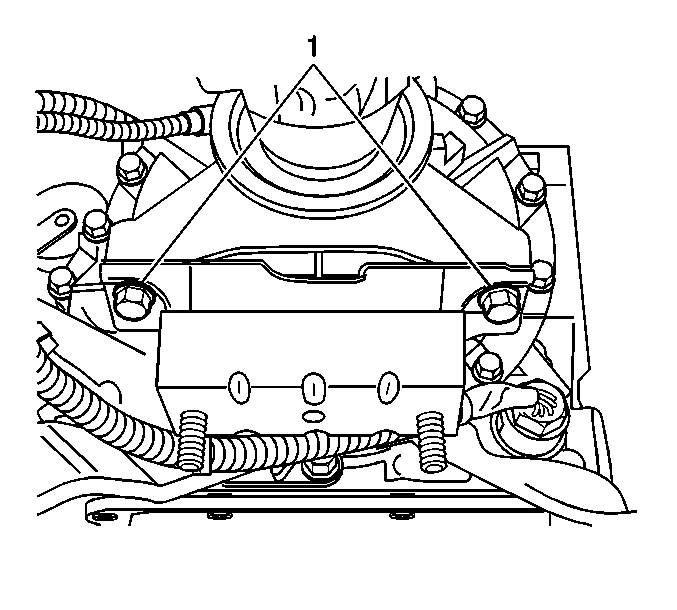
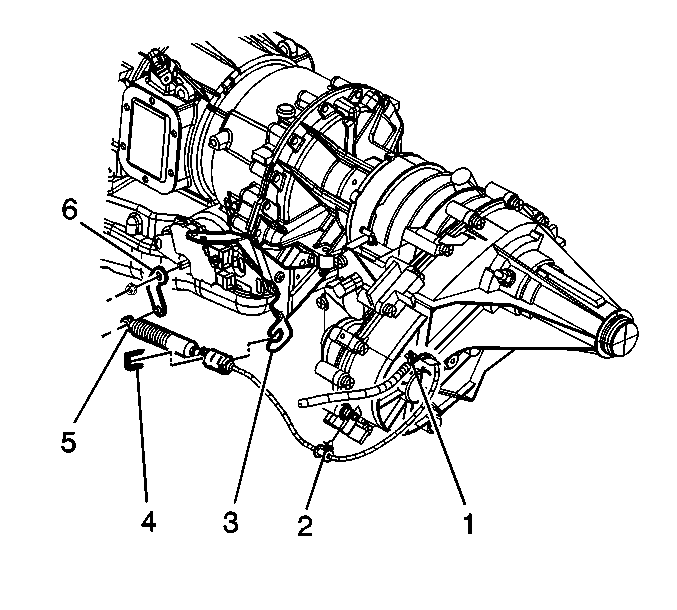
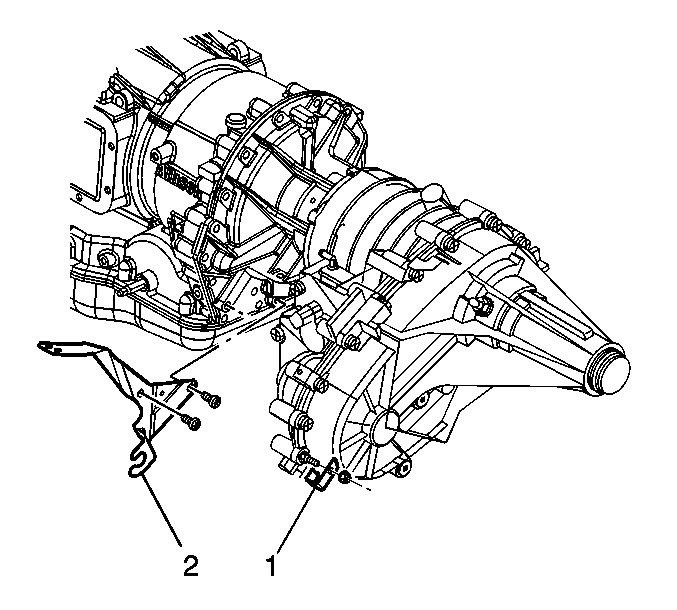
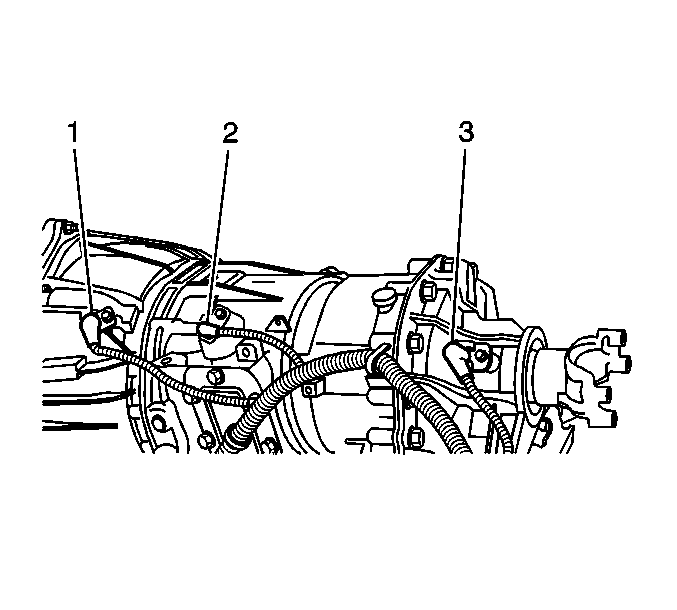
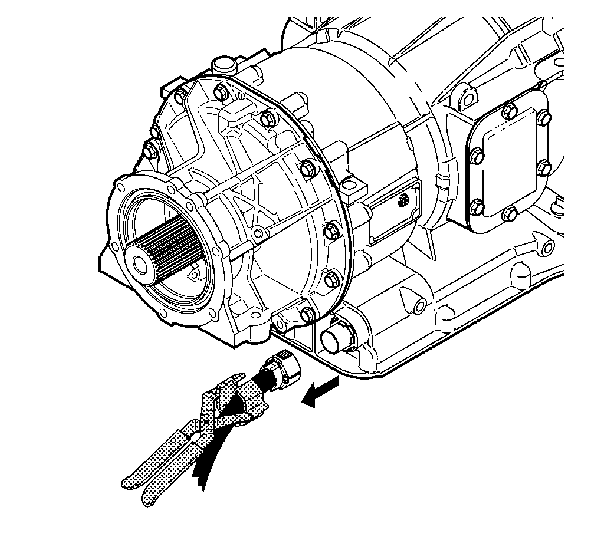
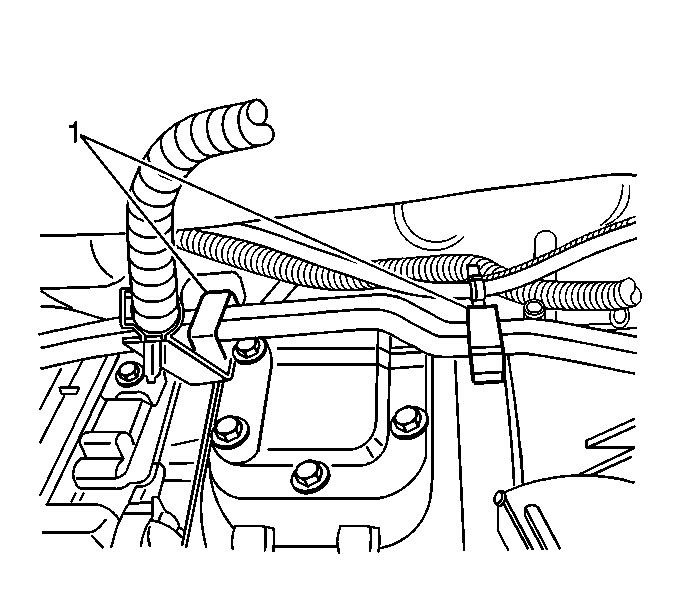
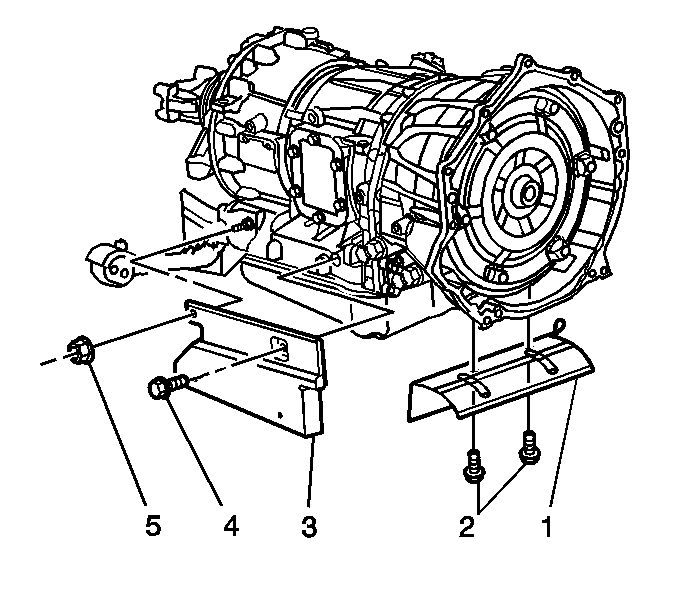
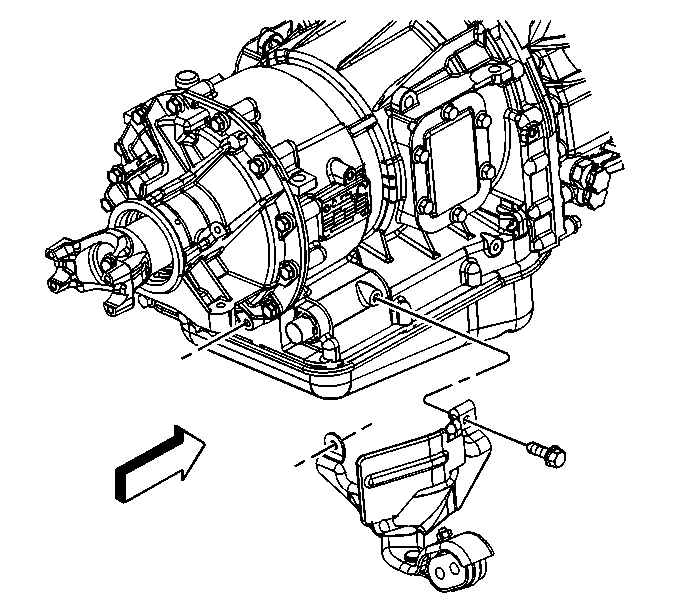

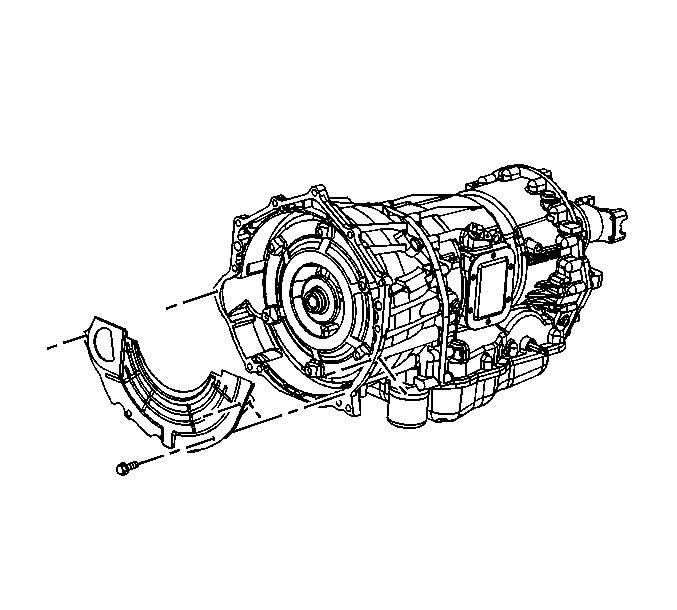
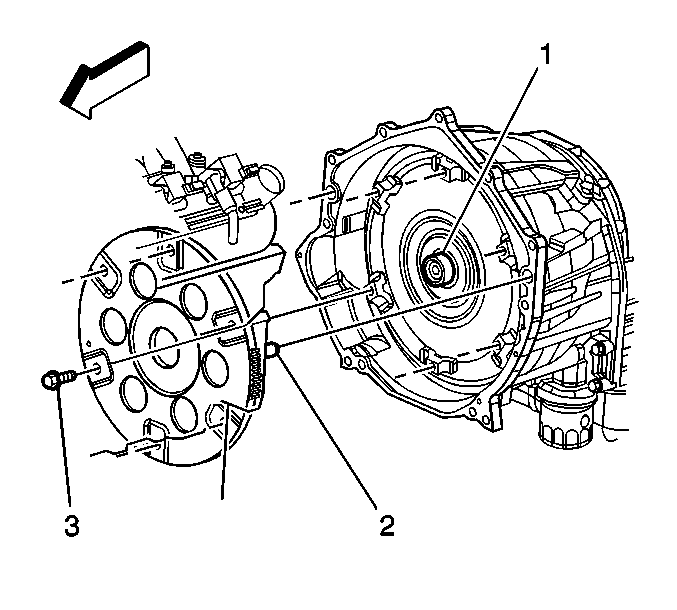
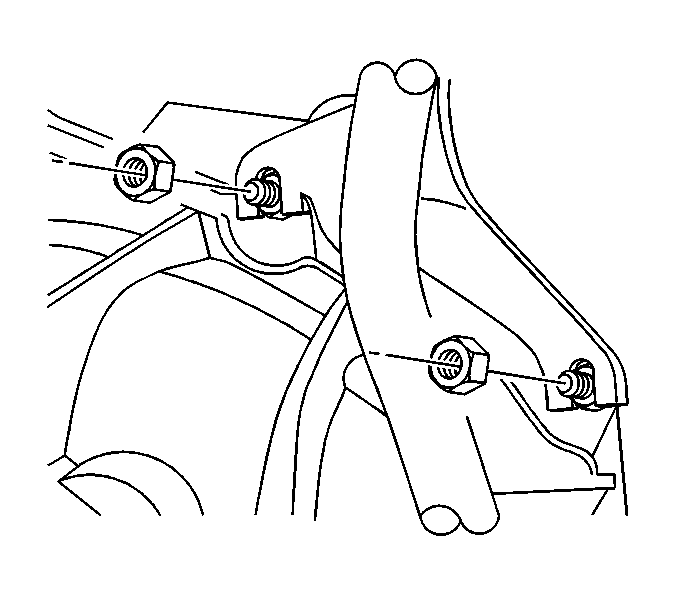
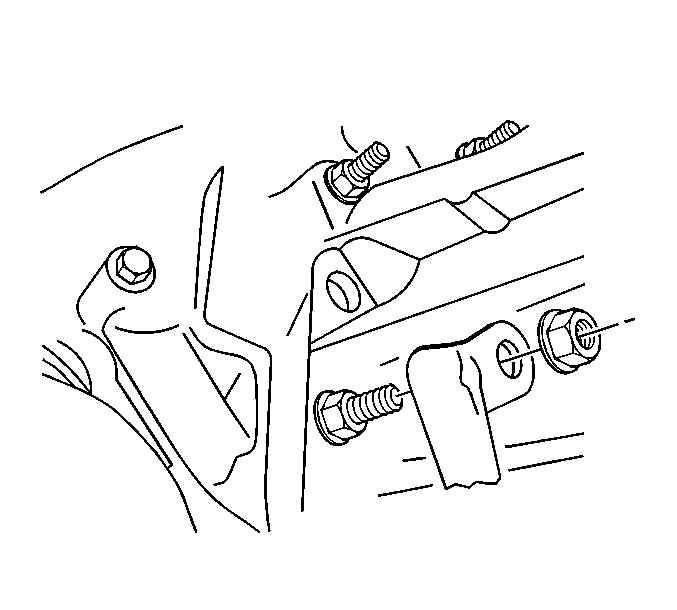

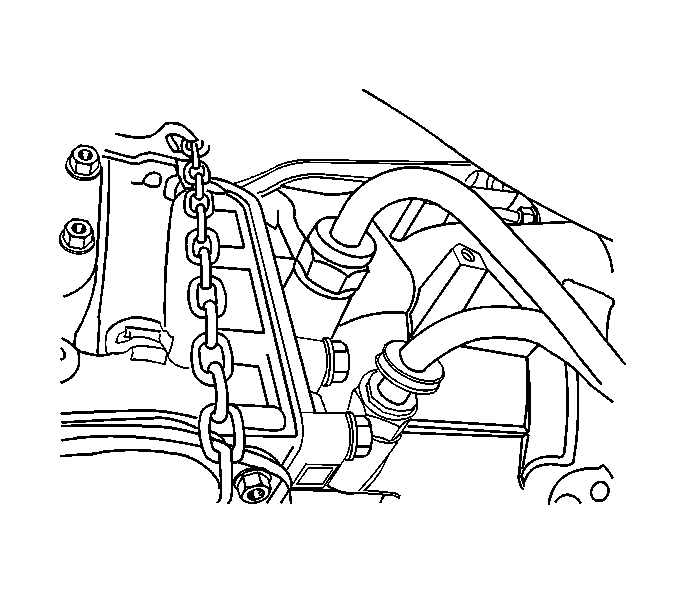
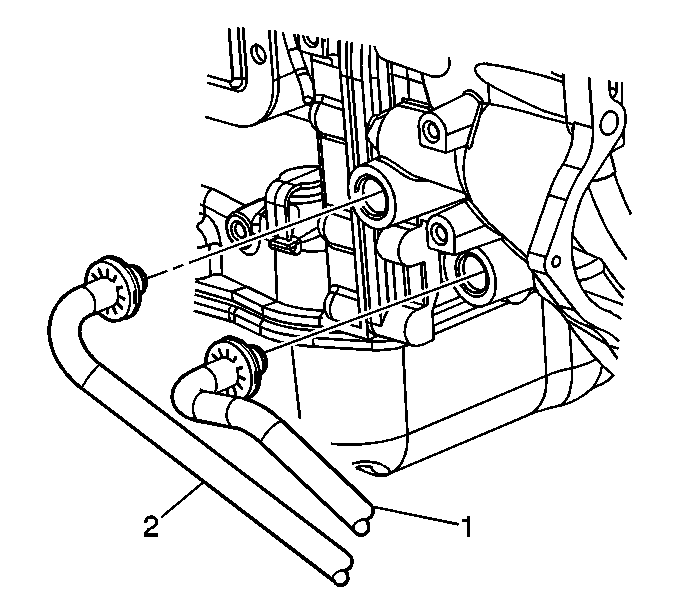
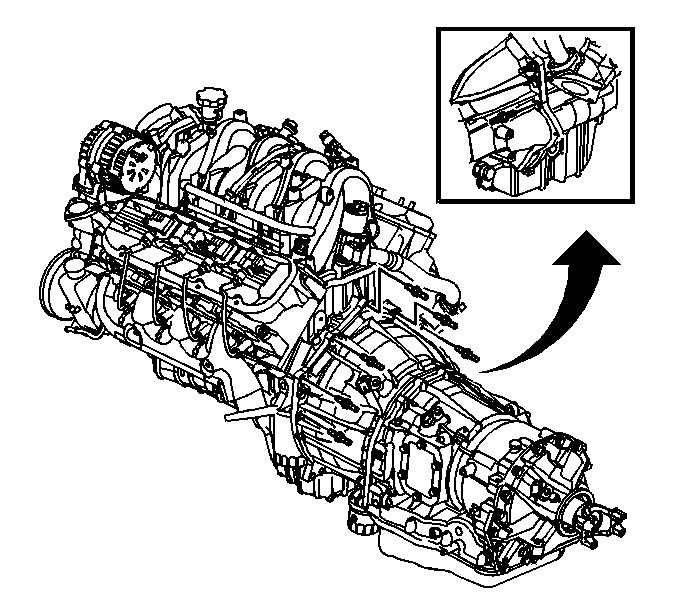
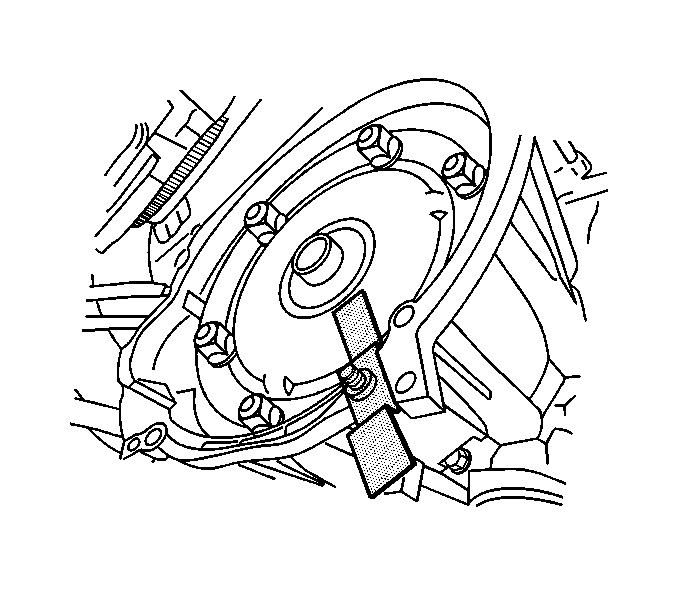
Installation Procedure
- Install J 21366 to the converter housing in order to keep the torque converter from sliding off of the turbine shaft.
- Raise the transmission into place while simultaneously installing the fill tube.
- Remove the J 21366 .
- Align the transmission with the engine using the alignment dowels located at the rear of the engine.
- Install the converter housing bolts and studs.
- Position the wire harness/vent tube bracket and install the wire harness/vent tube bracket nut to the converter housing stud.
- Install the fuel line bracket nut to the converter housing stud.
- Install the transmission fill tube nuts to the converter housing studs.
- Remove the safety chain from around the transmission.
- Rotate the engine clockwise, using the crankshaft bolt in order to access the torque converter bolts through the starter opening. Have an assistant rotate the engine while aligning the bolts.
- If reusing the torque converter bolts, clean the bolt threads and apply Loctite 242 GM P/N 12345382 (Canadian P/N 10953489), or equivalent to the threads prior to installation.
- Install the torque converter bolts (3).
- Install the converter housing inspection cover and bolts.
- Install the transmission heat shield (1) and bolts (2).
- Position the hanger and install the exhaust pipe hanger bolts.
- Install the transmission heat shield (3) and bolt/nut (4, 5).
- Install the fuel line retainer (1) bolts to the left side of the transmission.
- Connect the PNP switch electrical connector.
- Disconnect the transmission main electrical connector (2).
- Connect the output speed sensor (3) electrical connector. If the vehicle is equipped with 4WD, the output speed sensor is located on the transfer case and will be disconnected later.
- Connect the turbine speed sensor (1) and input speed sensor (2) electrical connectors.
- Install the shift cable bracket (2) and bolts to the transmission.
- Connect the shift cable to the selector lever ball stud (5) and install the cable to the bracket (3).
- Install the transmission mount.
- Install the transmission mount bolts (1).
- If the vehicle is equipped with 4WD, install the transfer case.
- If the vehicle is a 2WD, install the transmission support.
- If the vehicle is a 2WD, install the transmission support bolts and nuts.
- If the vehicle is a 2WD, install the transmission support bracket bolts.
- If the vehicle is a 2WD, install the transmission mount nuts.
- Remove the transmission jack from the transmission.
- If the vehicle is a 2WD, remove the propeller shaft. Refer to One-Piece Propeller Shaft Replacement or Two-Piece Propeller Shaft Replacement .
- Position the starter motor and install the starter motor bolts.
- Install the engine protection shield and bolts.
- If the vehicle is equipped with a PTO unit, connect and/or install any necessary components.
- Remove the plugs from the transmission oil cooler line fittings in the transmission case.
- Flush the transmission oil cooler and lines, if necessary. Refer to Transmission Fluid Cooler Flushing and Flow Test .
- Connect the transmission oil cooler lines (1, 2) to the transmission.
- Lower the vehicle.
- Connect the negative battery cable. Refer to Battery Negative Cable Disconnection and Connection .
- Fill the transmission with new transmission fluid.
- Install the transmission fluid level indicator.
- If a replacement transmission was installed, perform the "FastLearn" procedure using a scan tool. Refer to FastLearn Procedure .

Notice: Refer to Fastener Notice in the Preface section.

Important: Do not install the transmission by drawing it to the engine using the studs and bolts.
Tighten
Tighten the bolts/studs to 50 N·m (37 lb ft).

Tighten
Tighten the nut to 18 N·m (13 lb ft).

Tighten
Tighten the nut to 18 N·m (13 lb ft).

Tighten
Tighten the nuts to 18 N·m (13 lb ft).


Tighten
Tighten the bolts to 60 N·m (44 lb ft).

Tighten
Tighten the bolts to 10 N·m (89 lb in).

Tighten
Tighten the bolts to 17 N·m (13 lb ft).

Tighten
Tighten the bolts to 12 N·m (106 lb in).

Tighten
Tighten the bolt/nut to 17 N·m (13 lb ft).

Tighten
Tighten the bolts to 2.5 N·m (22 lb in).
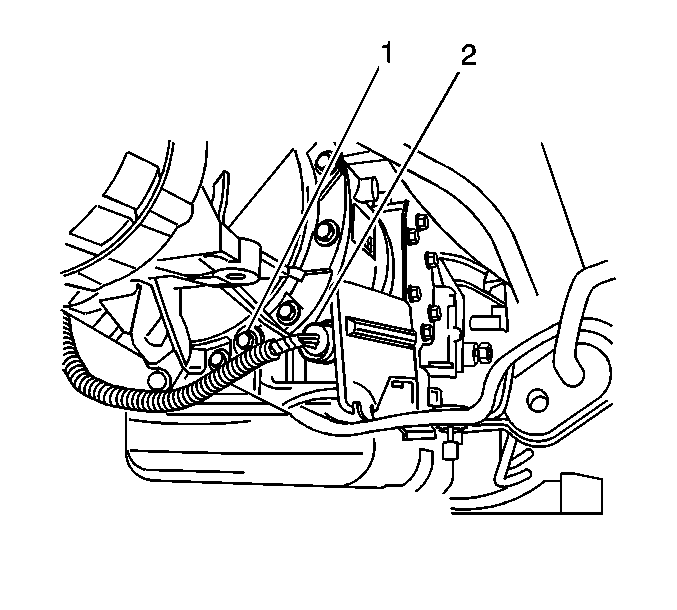


Tighten
Tighten the bolts to 25 N·m (18 lb ft).


Tighten
Tighten the bolts to 50 N·m (37 lb ft).
| • | If equipped with a NVG 261-NP2, refer to Transfer Case Assembly Replacement . |
| • | If equipped with a NVG 263-NP1, refer to Transfer Case Assembly Replacement . |

Tighten
Tighten the bolts/nuts to 95 N·m (70 lb ft).

Tighten
Tighten the nuts to 40 N·m (30 lb ft).

Tighten
Tighten the bolts to 50 N·m (37 lb ft).

Tighten
Tighten the bolts to 20 N·m (15 lb ft).

Transmission Replacement With 6.6L Engine
Tools Required
| • | J 21366 Converter Holding Strap |
| • | J 44257 Connector Removal Tool |
Removal Procedure
Important: If replacing a failed transmission, the "FastLearn" (adapt) procedure must be performed. This can be done in one step using a scan tool. If this procedure is not done, the transmission control module's (TCM's) adaptive values will still be at the settings that it learned for the old transmission, and will be in slow adaptive mode. Under these conditions, it would take an unacceptably long time for the adaptive values to converge to levels suitable for the new transmission.
- Disconnect both of the negative battery cables. Refer to Battery Negative Cable Disconnection and Connection.
- Remove the transmission fluid level indicator.
- Remove the cooling fan and shroud. Refer to Cooling Fan and Shroud Replacement.
- Raise the vehicle until the right front wheel and tire can be removed. Refer to Lifting and Jacking the Vehicle.
- Remove the right front wheel and tire.
- Remove the right front wheel house inner panel retainers (2).
- Disconnect any harness retainers attached to the inner panel.
- Remove the inner panel (1).
- Remove the positive battery cable nut and cable from the starter.
- Remove the solenoid nut and wire from the starter.
- Remove the starter motor bolts and reposition the starter.
- Remove the engine protection shield bolts and shield.
- Rotate the engine clockwise, using the crankshaft bolt in order to access the torque converter bolts thru the starter opening. Have an assistant rotate the engine while aligning the bolts.
- Remove the torque converter bolts.
- Completely raise the vehicle.
- Drain the transmission fluid.
- Disconnect the shift cable from the selector lever ball stud (5) and remove the cable from the bracket (3).
- Remove the shift cable bracket bolts and bracket (2) from the transmission.
- Reposition the bracket with the cable attached off to the side.
- Remove the fuel line retainer (1) bolts on the left side of the transmission.
- Remove the fuel line bracket nut from the converter housing stud.
- Disconnect the turbine speed sensor (1) and input speed sensor (2) electrical connectors.
- Disconnect the output speed sensor (3) electrical connector. If the vehicle is equipped with 4 wheel drive (4WD), the output speed sensor is located on the transfer case and will be disconnected later.
- Disconnect the transmission main electrical connector. J 44257 may be used, but is not required.
- Disconnect the park/neutral position (PNP) switch electrical connector.
- Remove the exhaust hanger bolts and reposition the hanger.
- If the vehicle is a 2 wheel drive (2WD), remove the propeller shaft. Refer to One-Piece Propeller Shaft Replacement or Two-Piece Propeller Shaft Replacement.
- Support the transmission with a transmission jack.
- If the vehicle is a 2WD, remove the transmission mount nuts.
- If the vehicle is a 2WD, remove the transmission support bracket bolts.
- If the vehicle is a 2WD, remove the transmission support bolts and nuts.
- Remove the transmission mount bolts (1).
- Remove the transmission mount.
- If the vehicle is equipped with 4WD, remove the transfer case.
- Reposition any wiring harness branches out of the way.
- Secure a safety chain around the transmission. Use care not to overlap any wiring, fuel lines, or other related components.
- Disconnect the transmission oil cooler lines (1, 2) from the transmission.
- Plug the transmission oil cooler line fittings in the transmission case, if necessary.
- If the vehicle is equipped with a power take off (PTO) unit , disconnect and/or remove any necessary components to facilitate transmission removal.
- Remove the transmission fill tube nuts from the converter housing studs.
- Remove the wire harness/vent tube bracket nut from the converter housing stud and reposition the bracket.
- Remove the remaining converter housing bolts and studs.
- Separate the transmission from the engine.
- Install J 21366 to the converter housing in order to keep the torque converter from sliding off of the turbine shaft.
- Carefully lower the transmission from the vehicle while simultaneously removing the fill tube.
- Remove the J 21366 .


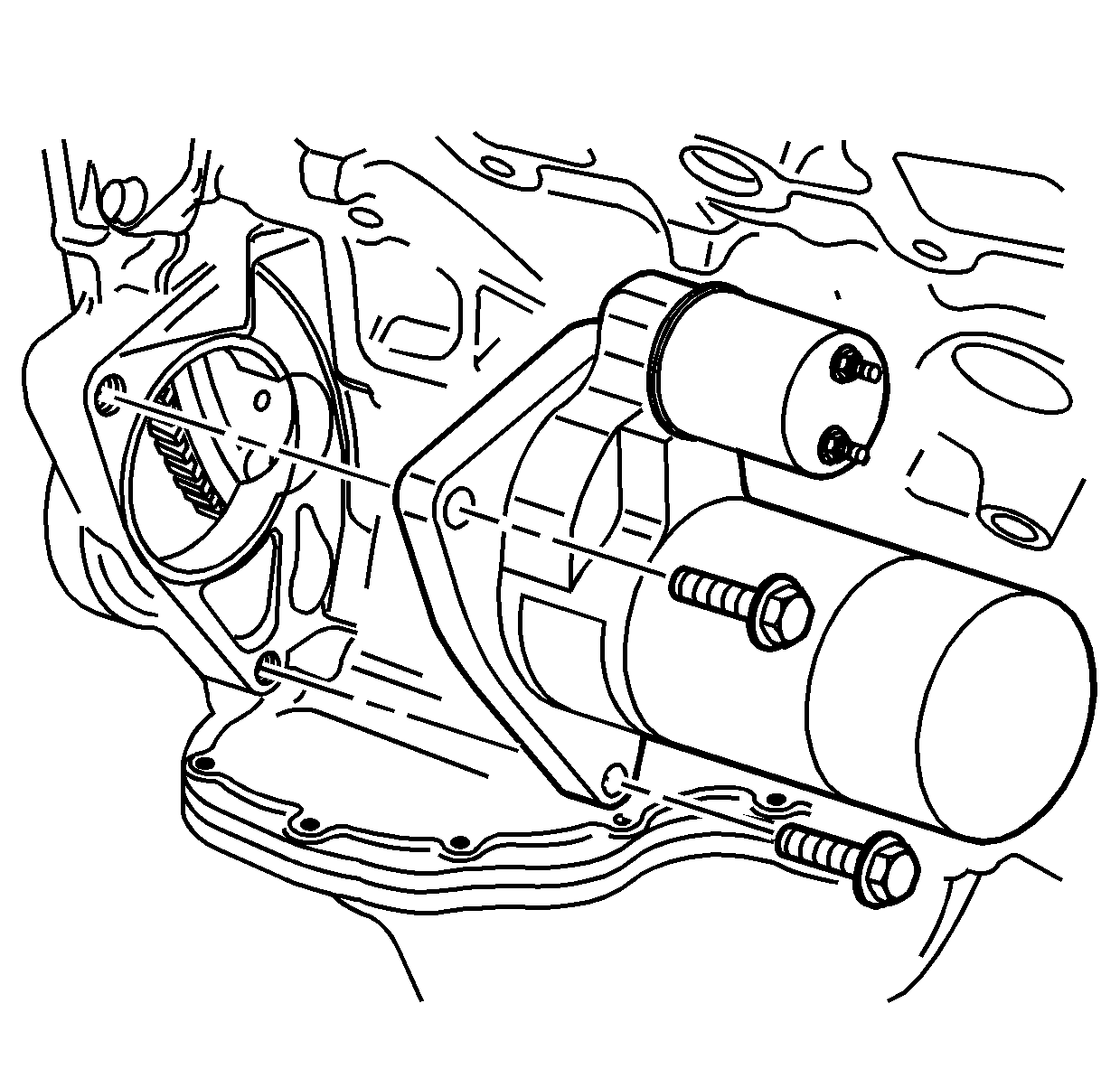


Important: Rotate the engine clockwise ONLY, rotating the engine counterclockwise may loosen the crankshaft balancer bolt.










| • | If equipped with a NVG 261-NP2, refer to Transfer Case Assembly Replacement. |
| • | If equipped with a NVG 263-NP1, refer to Transfer Case Assembly Replacement. |




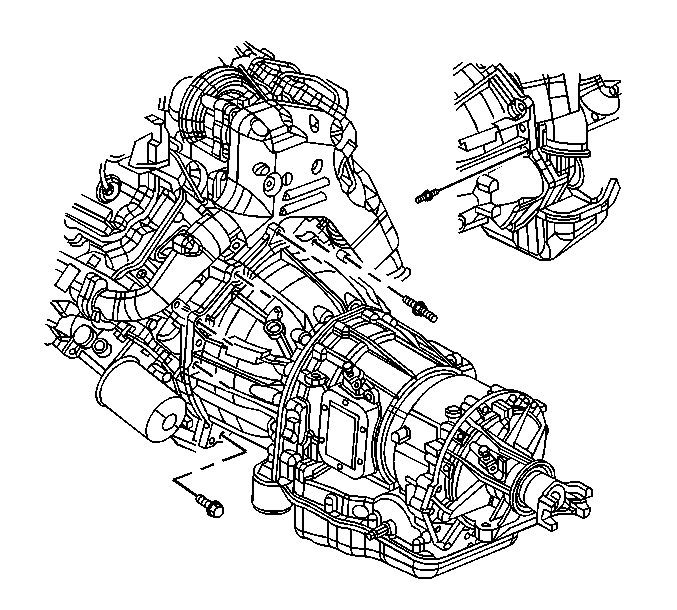

Installation Procedure
- Install J 21366 to the converter housing in order to keep the torque converter from sliding off of the turbine shaft.
- Raise the transmission into place while simultaneously installing the transmission fill tube.
- Remove the J 21366
- Align the transmission with the engine using the alignment dowels located at the rear of the engine.
- Install the converter housing bolts and studs.
- Install the wire harness/vent tube bracket and nut to the converter housing stud.
- Install the transmission fill tube and nuts to the converter housing studs.
- If the vehicle is equipped with a PTO unit, connect and/or install the components at this time.
- Remove the safety chain from around the transmission.
- Install the transfer case, if the vehicle is equipped with 4WD.
- If the vehicle is a 2WD, install the transmission mount.
- If the vehicle is a 2WD, install the transmission mount bolts (1).
- Install the transmission support.
- If the vehicle is a 2WD, install the transmission support bolts and nuts.
- If the vehicle is a 2WD, install the transmission support bracket bolts.
- If the vehicle is a 2WD, install the transmission mount nuts.
- Remove the transmission jack.
- If the vehicle is a 2WD, install the propeller shaft. Refer to One-Piece Propeller Shaft Replacement or Two-Piece Propeller Shaft Replacement.
- Position the exhaust hanger and install the bolts.
- Position the wiring harness branches.
- Connect the PNP switch electrical connectors.
- Connect the transmission main electrical connector (2).
- Connect the output speed sensor (3) electrical connector. If the vehicle is equipped with 4WD, the output speed sensor is located on the transfer case and has been connected during the transfer case installation.
- Connect the turbine speed sensor (1) and the input speed sensor (2) electrical connectors.
- Install the fuel line bracket and nut to the transmission converter housing stud.
- Install the fuel line retainer (1) and bolts to the left side of the transmission.
- Install the shift cable bracket (2) and bolts to the transmission.
- Install the shift cable to the bracket (3) and the selector lever ball stud (5).
- Remove the access hole cover (1) on the converter housing in order to rotate the converter and align the first torque converter bolt.
- If reusing the torque converter bolts, clean the bolt threads and apply LOCTITE 242 GM P/N 12345382 (Canadian P/N 10953489), or equivalent to the threads prior to installation.
- Install the torque converter bolts.
- Install the converter housing access hole cover.
- Install the engine protection shield and bolts.
- Position and install the starter motor bolts.
- Install the solenoid wire and nut to the starter.
- Install the positive battery cable and nut to the starter.
- Install the inner panel (1).
- Connect any harness retainers to the inner panel.
- Install the right front wheel house inner panel retainers (2).
- Install the right front wheel and tire.
- Remove the plugs from the transmission oil cooler line fittings in the transmission case, if necessary.
- Flush the transmission oil cooler and lines, if necessary. Refer to Transmission Fluid Cooler Flushing and Flow Test .
- Connect the transmission oil cooler lines (1, 2) to the transmission.
- Lower the vehicle.
- Install the cooling fan and shroud. Refer to Cooling Fan and Shroud Replacement.
- Connect both negative battery cables. Refer to Battery Negative Cable Disconnection and Connection .
- Fill the transmission with new transmission fluid.
- Install the transmission fluid level indicator.
- If a replacement transmission was installed, perform the "FastLearn" procedure using a scan tool. Refer to FastLearn Procedure .

Notice: Refer to Fastener Notice in the Preface section.

Important: Do not install the transmission by drawing it to the engine using the studs and bolts.
Important: Ensure that the torque converter can be rotated before tightening the bolts and studs.
Tighten
Tighten the bolts/studs to 50 N·m (37 lb ft).

Tighten
Tighten the nut to 18 N·m (13 lb ft).

Tighten
Tighten the nuts to 18 N·m (13 lb ft).

| • | If equipped with a NVG 261-NP2, refer to Transfer Case Assembly Replacement. |
| • | If equipped with a NVG 263-NP1, refer to Transfer Case Assembly Replacement. |

Tighten
Tighten the bolts to 50 N·m (37 lb ft).

Tighten
Tighten the bolts/nuts to 95 N·m (70 lb ft).

Tighten
Tighten the nuts to 40 N·m (30 lb ft).

Tighten
Tighten the bolts to 12 N·m (106 lb in).



Tighten
Tighten the nut to 18 N·m (13 lb ft).

Tighten
Tighten the bolts to 2.5 N·m (22 lb in).

Tighten
Tighten the bolts to 25 N·m (18 lb ft).

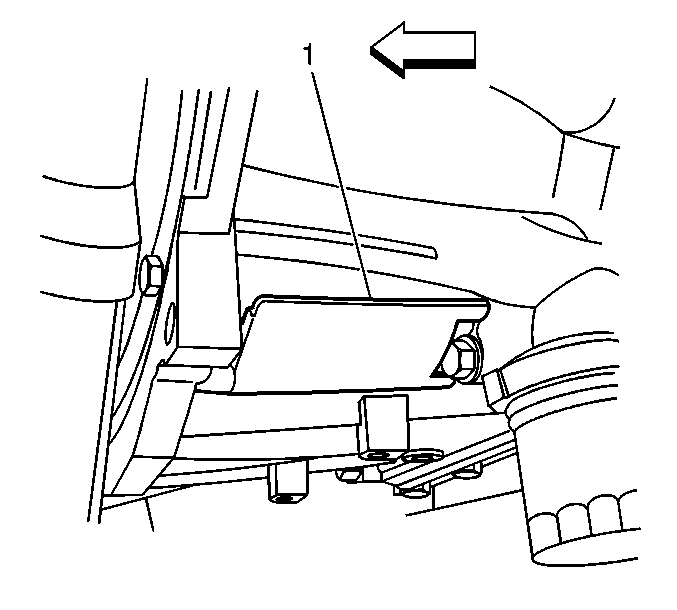

Tighten
Tighten the bolts to 60 N·m (44 lb ft).

Tighten
Tighten the bolts to 20 N·m (15 lb ft).

Tighten
Tighten the bolts to 78 N·m (58 lb ft).

Tighten
Tighten the nut to 3.4 N·m (30 lb in).
Tighten
Tighten the nut to 9 N·m (80 lb in).


